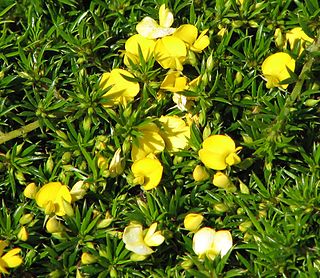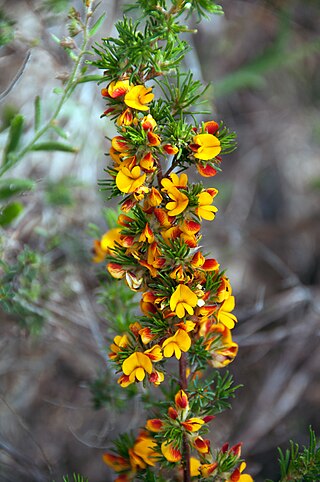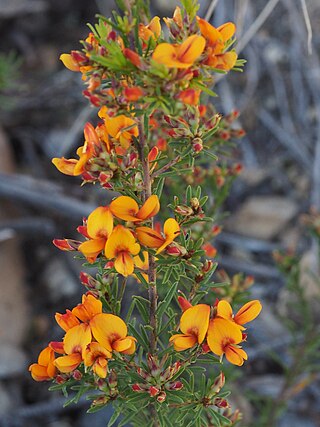
Correa baeuerlenii, commonly known as chef's-hat correa, or chef's cap correa, is a species of dense, rounded shrub that is endemic to the south-east of New South Wales, Australia. It has egg-shaped leaves and pendulous, greenish yellow flowers usually arranged singly on short side branches.

Pultenaea juniperina, commonly known as prickly bush-pea or prickly beauty is a species of flowering plant in the family Fabaceae and is endemic to south-eastern Australia. It is an erect, spiky shrub with hairy stems, linear to narrow elliptic leaves with stipules at the base, and yellow-orange and red flowers.

Pultenaea pedunculata, commonly known as matted bush-pea, is a species of flowering plant in the family Fabaceae and is endemic to south-eastern Australia. It is a prostrate, densely matted shrub with softly-hairy branches that often form roots, narrow elliptic leaves, and bright yellow and brick-red flowers.

Pultenaea acerosa, commonly known as bristly bush-pea, is a species of flowering plant in the family Fabaceae and is endemic to south-eastern continental Australia. It is a rigid, much-branched shrub with glabrous, grooved, needle-shaped leaves and yellow flowers with red veins.

Pultenaea aristata, commonly known as bearded bush-pea or prickly bush-pea, is a species of flowering plant in the family Fabaceae and is endemic to New South Wales. It is a small, erect shrub with linear to narrow elliptic, sharp-tipped leaves, and yellow and red flowers.
Pultenaea benthamii, commonly known as Bentham's bush-pea, is a species of flowering plant in the family Fabaceae and is endemic to south-eastern continental Australia. It is an erect shrub with sharply-pointed, narrow elliptic to linear leaves and yellow to orange and red flowers in clusters at the ends of branches.

Pultenaea canaliculata, commonly known as coast bush-pea, is a species of flowering plant in the family Fabaceae and is endemic to coastal areas of southern continental Australia. It is an rigid, spreading shrub with hairy, cylindrical leaves, and yellow and crimson flowers.
Pultenaea elusa, commonly known as elusive bush-pea, is a species of flowering plant in the family Fabaceae and is endemic to a small area of New South Wales. It is a low shrub with sharply-pointed linear leaves, and dense clusters of yellow to orange and red to purple flowers. It has not been seen since 1938.

Pultenaea glabra, commonly known as smooth bush-pea, is a species of flowering plant in the family Fabaceae and is endemic to eastern New South Wales. It is an erect shrub with glabrous stems, linear to egg-shaped leaves with a concave upper surface, and yellow to red and orange flowers.

Pultenaea hispidula, commonly known as rusty bush-pea, is a species of flowering plant in the family Fabaceae and is endemic to south-eastern continental Australia. It is an erect, spreading shrub with many drooping branches, oblong to egg-shaped leaves with the narrower end towards the base, and yellow to pale orange and red flowers.

Pultenaea humilis, commonly known as dwarf bush-pea, is a species of flowering plant in the family Fabaceae and is endemic to south-eastern Australia. It is a spreading, often low-lying shrub with branches that are hairy when young, elliptic to lance-shaped leaves with the narrower end towards the base, and yellow to orange and red flowers.

Pultenaea largiflorens, commonly known as twiggy bush-pea, is a species of flowering plant in the family Fabaceae and is endemic to south-eastern continental Australia. It is a rigid, erect shrub with narrow egg-shaped leaves with the narrower end towards the base, and bright yellow and crimson flowers.

Pultenaea laxiflora, commonly known as loose-flower bush-pea, is a species of flowering plant in the family Fabaceae and is endemic to south-eastern continental Australia. It is a low-lying to prostrate, spreading shrub with linear to narrow egg-shaped leaves with the narrower end towards the base, and yellow and red to brown or purple flowers.

Pultenaea parrisiae, commonly known as bantam bush-pea, or Parris's bush-pea, is a species of flowering plant in the family Fabaceae and is endemic to south eastern continental Australia. It is a low-lying sub-shrub with linear to lance-shaped leaves with the narrower end towards the base, and yellow to purple flowers with red markings.

Pultenaea parviflora, sommonly known as Sydney bush-pea, is a species of flowering plant in the family Fabaceae and is endemic to eastern New South Wales. It is usually a small, erect shrub with wedge-shaped to narrow egg-shaped leaves with the narrower end towards the base, and clusters of yellow to orange and red flowers.

Pultenaea pycnocephala, commonly known as dense-head bush-pea, is a species of flowering plant in the family Fabaceae and is endemic to eastern Australia. It is an erect shrub with hairy branches, egg-shaped leaves with the narrower end towards the base and yellow to red and purple, pea-like flowers.
Pultenaea rodwayi is a species of flowering plant in the family Fabaceae and is endemic to south-eastern New South Wales. It is an erect shrub with hairy branchlets, linear leaves, and yellow to orange and red, pea-like flowers.
Pultenaea sericea, commonly known as chaffy bush-pea, is a species of flowering plant in the family Fabaceae and is endemic to south-eastern Australia. It is a small, straggling shrub with hairy branches, elliptic to linear leaves, and yellow and red to purple, pea-like flowers.

Pultenaea williamsoniana, commonly known as Williamson's bush-pea, is a species of flowering plant in the family Fabaceae and is endemic to a restricted area of Victoria, Australia. It is a slender, erect shrub with its stems covered with white hairs, and has cylindrical, grooved leaves and yellow to orange and red, pea-like flowers arranged in clusters on the ends of short side branches.

Pultenaea campbellii commonly known as New England bush-pea or ragged bush-pea, is a species of flowering plant in the family Fabaceae and is endemic to New South Wales. It is an erect shrub with linear leaves and yellow-orange flowers arranged near the ends of branchlets.
















